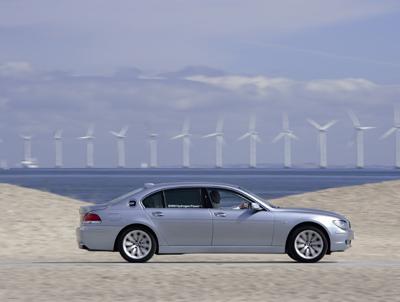Opening up a new era of mobility: Bmw hydrogen7
 • World's first hydrogen-powered luxury saloon for everyday use, trendsetting model within the BMW 7 Series based on the BMW 760Li, milestone in achieving a new standard of mobility free of pollutants and with full sustainability.
• World's first hydrogen-powered luxury saloon for everyday use, trendsetting model within the BMW 7 Series based on the BMW 760Li, milestone in achieving a new standard of mobility free of pollutants and with full sustainability.• Complete integration of hydrogen technology in the process of series development, driving dynamics and motoring refinement typical of BMW, wide range of premium comfort features, production parallel to the BMW 7, 6, and 5 Series at BMW Plant Dingolfing.
• Dual-mode twelve-cylinder combustion engine for a long cruising range and superior driving dynamics, based on BMW's twelve-cylinder 6.0-litre gasoline engine featuring VALVETRONIC in the BMW 7 Series; maximum output 191 kW/260 hp, peak torque 390 Newton-metres/287 lb-ft at 4,300 rpm, acceleration to 100 km/h in 9.5 sec, top speed 230 km/h (143 mph), limited electronically.
• Direct fuel injection in the gasoline mode, external mixture formation with intake manifold injection in the hybrid mode, same engine output in both operating modes, smooth and consistent switchover with no time-lag from one operating mode to another, flexible engine management with VALVETRONIC and double-VANOS, innovative injection valves as key technology for hydrogen drive.
• Hydrogen tank accommodating approx 8 kilos of liquid hydrogen, gasoline tank with a capacity of 74 litres or 16.3 Imp gals, liquid hydrogen as drive energy for a long cruising range and a high standard of everyday use, more than 200 kilometres/125 miles cruising range on hydrogen plus 500 kilometres/310 miles on gasoline.
• Engine emits virtually nothing but vapour in the hydrogen mode, practical solution for rapid reduction of CO2 emissions and changeover to drive energy independent of fossil fuels, pacemaker for ongoing progress.
• Trendsetting vacuum super-insulation for the hydrogen tank, liquid hydrogen consistently and for a long time remaining at a temperature of - 253 °Celsius, same insulating effect as with a 17-metre-thick layer of styrofoam.
• Simple, clean and risk-free tank-filling process, tank filler manifold connected to liquid hydrogen filler pipe in the same way as with
a conventional fuel pump, tank manifold and filling process locked in position and conducted by system control.
• High powerdome as a clear sign of distinction highlighting BMW Hydrogen 7, clear reference to the high-rising engine modified in its dimensions
on account of hydrogen injection valves, weight- and crash-optimised combination of carbon-fibre-reinforced plastic (CFP) and steel body components.
• Modifications inside the car: rear Seat bench moved 115 millimetres/4.5´´ further to the front than in the BMW 760Li due to the arrangement of the hydrogen tank and 25 millimetres/1.0´´ further to the rear than in the BMW 760i, centre console fitted firmly on the rear Seat bench on account of the car''s package, four seats, special hydrogen function displays in the cockpit.
• Independent, non-partisan safety certification, successful completion of comprehensive test series conducted by the South German Technical Inspection Authority (TÜV South Germany), sensor-based control system operating independently of the engine, hydrogen components with multiple redundancy/back-up.
• Chassis and suspension with double-joint tiebar spring strut axle at the front and integral-IV multi-arm axle at the rear, BMW AdaptiveDrive
with anti-roll stabilisation and electronic damper control, telemetric TPC Tyre Pressure Control system.
• Innovative remote diagnosis system, direct dialogue with driver/vehicle user.
• First series production car based on decades of BMW experience in testing hydrogen as a drive technology, development and examination of hydrogen engines since the 1980s.
• Promotion of nationwide hydrogen supply infrastructure by the BMW Group in close cooperation with the Clean Energy Partnership Berlin, BMW Hydrogen 7 acting as a series production hydrogen car for everyday use and establishing new momentum for ongoing development and expansion of a complete, all-round network of filling stations.